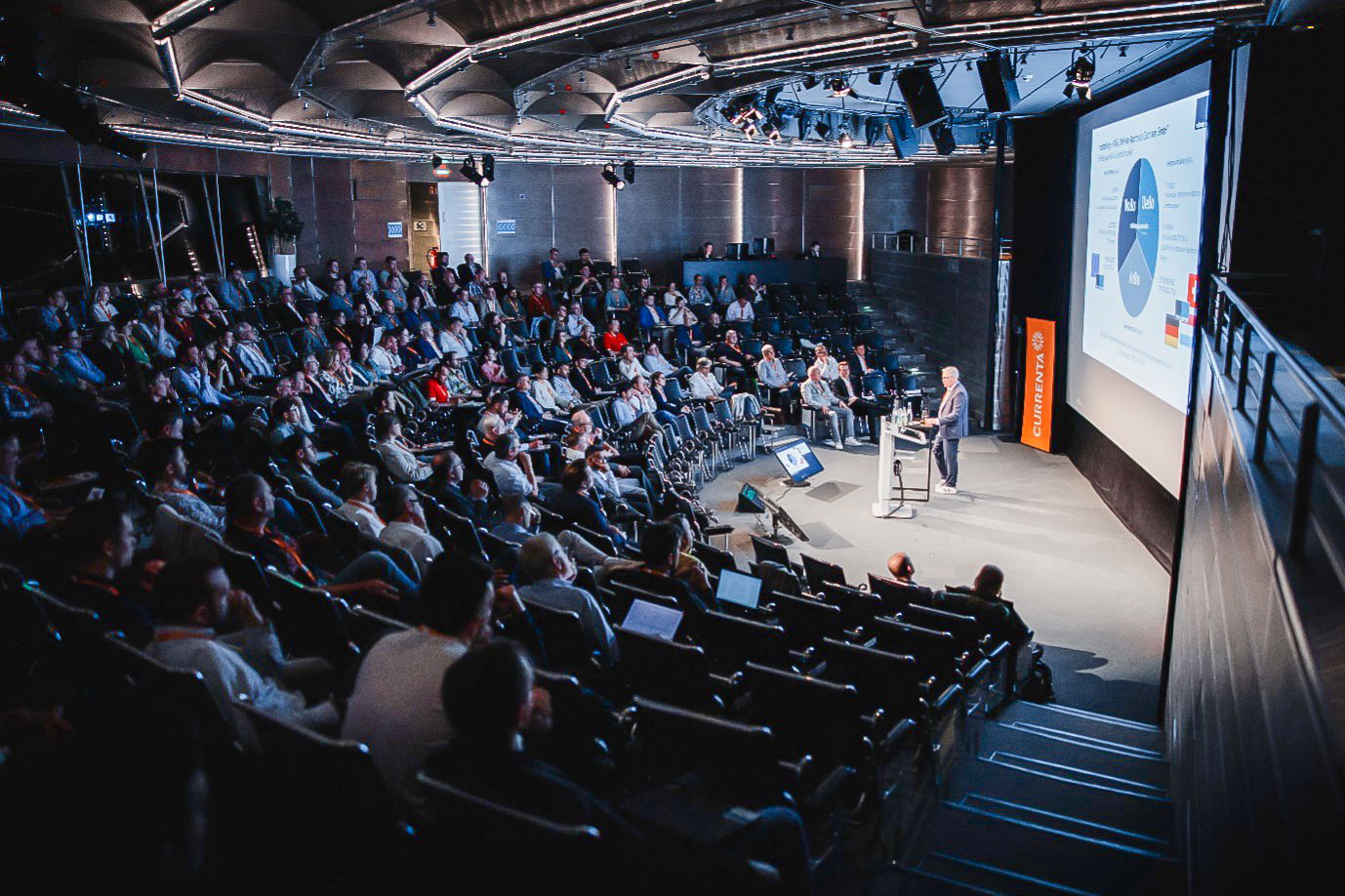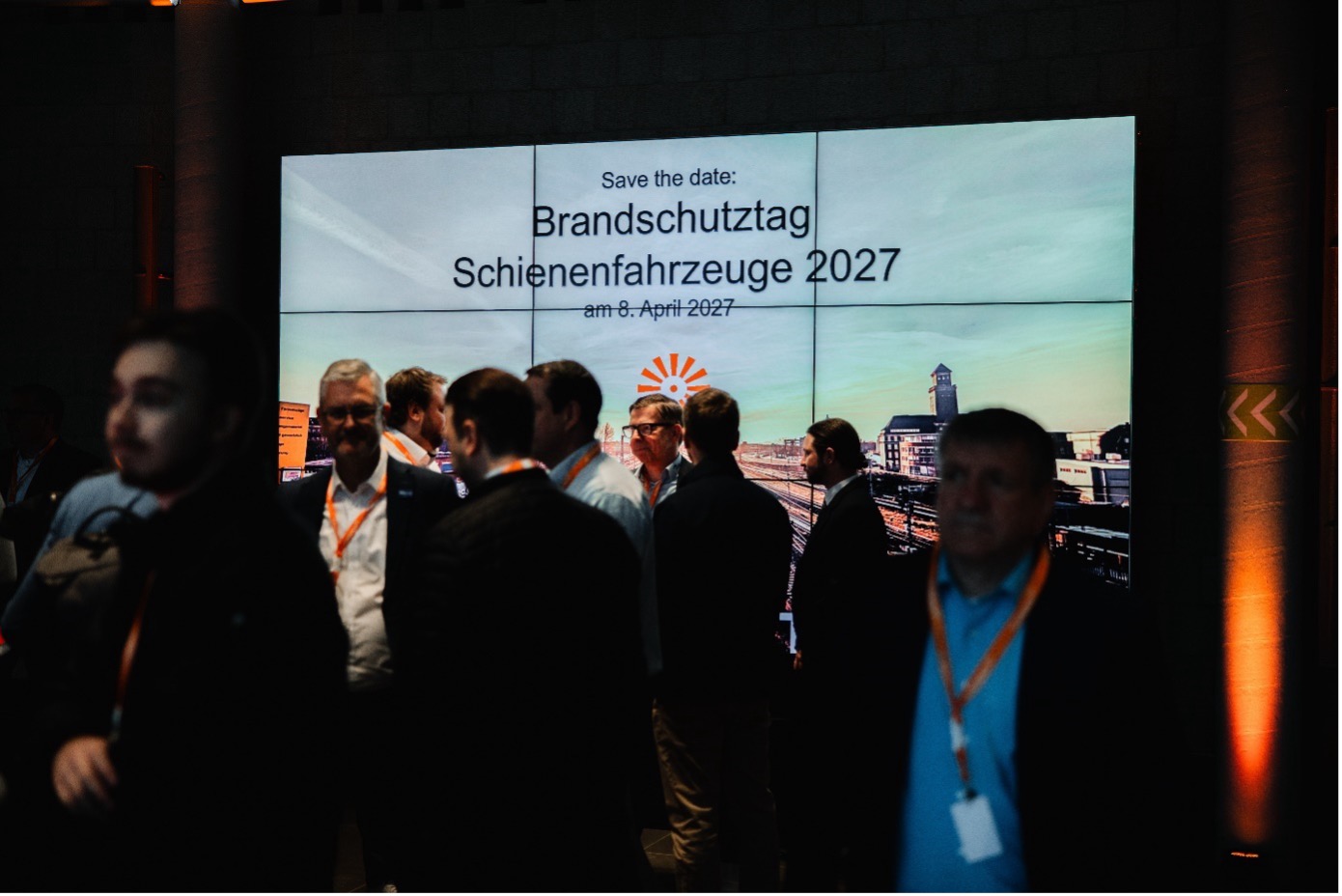Home » Report on the Fire Protection Day 2025
That was Fire Safety Day 2025:
Please do not hesitate to contact us if you have any questions. Write to us at:
Report on the Fire Protection Day 2025
Rail Vehicle Fire Protection Conference 2025 – hot topics and high-profile speakers

Numerous railway experts from across the German-speaking region once again gathered in Leverkusen for the 18th edition of the Rail Vehicle Fire Protection Day. The industry event focused on current trends in testing standards and the latest findings from research and technology.
With around 150 participants from 90 different companies and institutions, the 18th Fire Protection Day on 10 April 2025 at Baykomm once again demonstrated that it is the leading event in the German-speaking world for all fire technology topics and issues in rail transport.
For newcomers to the world of testing standards and fire tests on new and established materials and products, the symposium offered by Currenta is often used as a training event. But even for experts, there is always an update on the latest topics and trends in fire protection, as well as the opportunity to meet and exchange ideas with a wide variety of players and representatives at the industry gathering.
For the first time, Michael Halfmann and Alexander Kuchner jointly opened the event with eight speakers, which traditionally took place at BayKomm in Leverkusen. For Mr Kuchner, it was his second appearance at the Fire Protection Day. He has been head of the fire testing facility for a year and has been deepening his expertise at Currenta for four years now.
EU target: borderless rail transport and a liqueur with a signal effect
Andreas Schirmer from the European Railway Agency (ERA) presented the New Legislative Framework (NLF) and the Technical Specifications for Interoperability (TSIs) at a specialist conference. The aim is to create a safe, sustainable and cross-border rail system in Europe.
A particularly illustrative example was the Cassis de Dijon principle: a legal dispute between the REWE Group and the German Spirits Monopoly Act showed that products that are legally sold in one EU country must also be approved in other Member States. This principle symbolises the removal of technical and legal barriers to trade – including in the railway sector.
The ERA plays a key role in this: it ensures uniform standards and safety and creates the framework conditions for vehicle approvals. This is complemented by the 4th Railway Package of 2016, which further strengthens the role of the ERA.
Certification as the key to safe rail transport
Reiner Heldt from Railway Approvals Germany GmbH presented key aspects of vehicle certification in European rail transport. The focus was on the legal basis, types of approval and the application of fire safety standard EN 45545-2 – both within the scope of the Technical Specifications for Interoperability (TSI) and beyond, for example in trams in accordance with BOStrab.
The differences between the 2016 and 2020 versions of the standard were presented in a particularly practical manner, for example in terms of test standards, requirements for seating systems and smoke toxicity. Compliance with these standards is crucial for the safety, interoperability and acceptance of new vehicles. Heldt emphasised that a clearly structured certification process creates trust and promotes innovation.
In the context of the European Green Deal and the desired reduction in CO₂ emissions, certification is a key instrument for further expanding rail transport as a sustainable mobility solution.
Hot numbers, clear standards: How fire tests ensure safety on the rails
For Sebastian Schulz from Currenta Brand Technology, it was a home game at Fire Protection Day 2025, where he gave a comprehensive overview of fire technology testing methods and key figures in the context of the EN 45545 series of standards.
The focus was on test methods for flammability, flame spread, heat release, smoke density and gas toxicity, as well as fire resistance. Schulz explained the significance of these parameters for the safety of rail vehicles and showed how they are evaluated depending on design and operating classes. He also presented test methods from the US standard NFPA 130 and compared them with European procedures. The presentation of the test conditions and limit values, for example for the oxygen index (OI), maximum heat release (MARHE) or conventional toxicity index (CIT), was particularly practical. The presentation emphasised the central role of standardised test procedures for preventive fire protection and the safe design of modern rail vehicles.
Between DIN, EN and ISO: Fire protection on an international track
Philip Gallandi from DIN e. V. presented national and international standardisation work in the field of fire protection for rail vehicles. The focus was on the development of the ISO 9828 series of standards, which will define future requirements for materials, electrical equipment and fire protection systems.
Gallandi explained the various levels of standardisation and emphasised the importance of harmonised standards for interoperability in European rail transport. The new ‘Online Standard Drafting’ platform enables efficient, collaborative standardisation.
Particularly relevant: the options for incorporating ISO 9828 into the European standardisation system – from parallel existence to complete integration with adaptations. The presentation showed how standardisation not only creates technical safety, but also regulatory clarity and flexibility for the future of rail transport.
Old meets new – challenges in modernisation
At the conference, Frank Lüders from DB Systemtechnik highlighted the implementation of fire safety regulations in the modernisation and maintenance of rail vehicles. The focus was on verification in accordance with DIN EN 45545-2, the definition of hazard levels and the selection of suitable standards.
Interface problems with existing vehicles are particularly challenging, for example due to the integration of new systems such as Wi-Fi or PRM adaptations, which are difficult to reconcile with old materials. Lüders demonstrated in a practical manner how fire safety assessments, inspections and material analyses help to develop safe solutions – for example, when refurbishing surfaces with new composite materials. His conclusion: fire safety standards not only influence new construction, but increasingly also maintenance. In future, fire safety must be taken into account when selecting materials for later modernisation.
Between risk and regulations: e-mobility in rail transport
Corinna Trettin from TÜV Süd presented the safety challenges involved in transporting e-scooters and e-bikes by rail at the conference. The focus was on the properties of lithium-ion batteries, in particular the risk of thermal runaway due to overcharging, short circuits or mechanical damage.
Using a fire risk analysis for e-scooters in passenger compartments, Trettin showed how ignition sources, the probability of ignition and the effects are assessed. The analysis is based on applicable guidelines such as the Machinery and Low Voltage Directives and EN 60812. The safety requirements for e-bikes and e-scooters are virtually identical – the decisive factor is operator responsibility. She concludes that the transport of e-scooters is possible if the accepted residual risk is assessed on a project-specific basis and appropriate risk mitigation measures are taken.
Simulation instead of speculation – The path to standardised design fires
Manuel Osburg from Brandschutz Consult Ingenieurgesellschaft (BCI) presented the importance and methodology of design fires for fire protection in rail vehicles at the conference. A distinction was made between vehicle-related fire protection in accordance with EN 45545 and infrastructure-related protection in accordance with EBA specifications and DIN 5647.
Osburg explained the differences between standardised and individual design fires: while standardised models are conservative and idealised, individual approaches enable a realistic prediction of fire spread – based on fire tests, simulations and material data. Particular emphasis was placed on the role of ignition scenarios, ventilation conditions and the position of the ignition source. Currently, there is no uniform standard, which leads to high costs and inconsistent results. The goal is to develop a methodological guideline with clear specifications, quality management and validation. The BESKID project uses AI-based data to further develop design fire simulations – an innovative step towards reproducible and practical fire protection concepts in rail transport.
Fire simulation meets real fire tests
On Fire Safety Day, Gerhard Murtinger gave a humorous presentation on how Siemens Mobility validated fire simulations using real fire tests. The aim is to model the behaviour of rail vehicles in the event of a fire as realistically as possible – for example, to assess their ability to continue running, the spread of fire or the spread of smoke. Complex pyrolysis models can be used to realistically simulate the thermal behaviour of materials. These models were tested in targeted fire tests – from cone calorimeters to large-scale fire tests with a complete rail vehicle.
The results show that only by combining simulation and real measurement data can reliable statements be made about fire spread, heat release and smoke spread. Realistic pyrolysis modelling in particular proves to be the key to precise fire simulations. It enables a well-founded assessment of safety-relevant scenarios and supports the development of robust fire protection concepts in rail transport.
Review and outlook: Conference on fire protection in rail transport
With eight high-profile presentations, the conference offered comprehensive insight into current developments in fire protection in rail transport. Topics ranged from normative standards such as EN 45545 and ISO 9828 to certification processes and material testing, as well as realistic fire simulations and risk assessments for e-mobility. One thing became particularly clear: the requirements for safety, interoperability and sustainability are increasing – as is the complexity of modernisation, maintenance and approval. The exchange between industry, testing institutions and standardisation bodies showed how important practical solutions, valid testing methods and harmonised standards are. Looking to the future, artificial intelligence, data-based simulations and flexible standardisation strategies will play a central role in ensuring safe, modern and climate-friendly rail transport in Europe.
On the morning after the conference, numerous participants in the 18th Fire Protection Day for Rail Vehicles took part in small group tours of the Currenta fire test facility.
One thing is already certain: the next Fire Protection Day on 8 April 2027 will pick up where this one left off – with new ideas, in-depth discussions and the goal of making fire protection in rail transport even more future-proof.

The speakers and the programme
10 April 2025
Speakers
Philip GALLANDI
DIN-Normenausschuss Fahrweg und Schienenfahrzeuge, Berlin
Michael HALFMANN
Currenta – Analytik FMA, Leverkusen
Rainer HELDT
Railway Approvals Germany GmbH, Hannover
Alexander KUCHNER
Currenta – Analytik Brandtechnologie, Leverkusen
Frank LÜDERS
DB Systemtechnik GmbH, Brandenburg-Kirchmösern
Gerhard MURTINGER
Siemens Mobility Austria GmbH, Wien
Manuel OSBURG
Brandschutz Consult Ingenieurgesellschaft mbH, Leipzig
Andreas SCHIRMER
European Union Agency for Railways, Valenciennes Cedex
Sebastian SCHULZ
Currenta – Analytik Brandtechnologie, Leverkusen
Corinna TRETTIN
TÜV SÜD Rail GmbH, Berlin
Programme
Admission (Meet & Greet)
Welcome (HALFMANN & KUCHNER)
“New Legislative Framework” (NLF) and TSIen (SCHIRMER)
Experience from the perspective of a Notified Body – NoBo (HELDT)
Coffee break
Fire technology testing – overview of methods and key figures (SCHULZ)
Fire safety standardisation and work on the international standard for rail vehicles – ISO 9828 (GALLANDI)
Challenges in the implementation of fire protection regulations in the modernisation and maintenance of rail vehicles (LÜDERS)
Discussion, followed by a lunch break with snacks
The challenge of taking e-mobility with you on rail transport (TRETTIN)
From research to practice: A guide for the development of design fires for railway vehicles (OSBURG)
Validation of fire simulations on the basis of real fire tests (MURTINGER)
Closing remarks, followed by an opportunity for further discussion in the foyer
End of the event